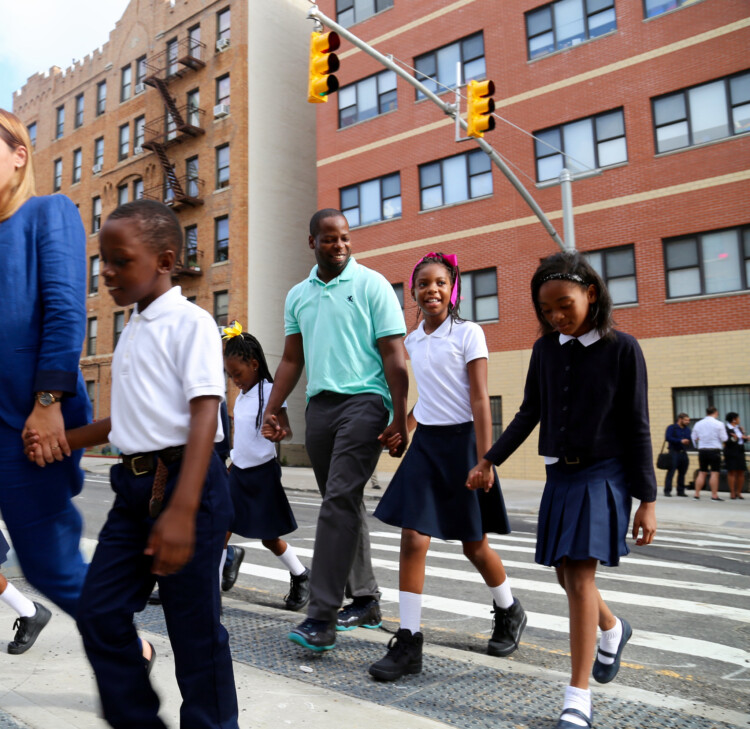Immigration and U.S. Public Schools
As U.S. schools grow more diverse, districts across the country have initiated racial equity plans to create inclusive environments for all students. I study how districts manage the influx of newcomer immigrant youth and how they foster school and social belonging. In this work, I locate racialization (i.e., any process of othering and categorizing groups by race) at the heart of the unequal distribution of resources for immigrant youth, as well as their (often unwelcoming) experiences in schools and communities. To date, few scholars have interpreted immigration as a racial equity issue and recent research encourages educators, policy-makers, and researchers to advance race-conscious equity efforts.
Preliminary findings from my current study suggest a misalignment between what school districts say they are doing to advance equity and what Latinx immigrant youth are feeling. Racial equity involves thinking about identity, belonging, power, and the effects of immigration and cultural differences between students and school personnel. So far, my mixed-methods work has shown that, despite efforts to improve school climate, Latinx immigrant youth have experienced racial antagonism from other students and a lack of support from school-based personnel, including educators, leaders, and staff. What are the challenges to aligning district efforts and student experiences, and how might districts improve?
Improving unwelcoming school climates that challenge Latinx youth belonging
Students’ sense of belonging may be characterized as their feeling heard, respected, and affirmed in their identities. A lack of belonging arises when schools do not signal affirmation of Latinx identity or fail to establish trusting relationships between students and adults. In one of my recent surveys with a mid-sized district on the east coast, one youth expressed:
“Even though there are rules against racial discrimination mainly with the “n word”, me and multiple others feel less supported than we should because we have encountered multiple racist situations either in front of teachers or we have been in a situation and went to a teacher for help, [and] we have not gotten the help we needed.”
We know from past research the importance of cultivating positive school climates and strong adult-student relationships. When school rules or norms do not support immigrant youth or provide tools for handling racist incidents with peers or teachers, these students feel like they do not belong.
According to over 3,700 middle and high school survey respondents in multiple school districts, a school’s racial climate is the strongest determinant of students’ belonging. Many Latinx students reported limited opportunities to feel heard or have a trusted adult to talk to about racial incidents at school.
If school districts are to pursue racial equity, they must first improve the racial climate at schools. Here, a central element is acknowledging authentic student voices (especially those of minoritized youth). Consider the following comments, from two Latinx students:
“With an altercation with a Hispanic student, they don’t let anything slide.”
“The security guards at my school are racist. I just walk to the bathroom or class and then they say that I have to go back to class because I don’t have a pass but I clearly do. But when the same race as them walks past them and they are actually skipping they don’t say anything.”
The student quoted above suggested that White students were treated differently—i.e., with more understanding—than Latinx and other minoritized students. Other students also reported that unequal treatment by school staff can enhance existing racial tensions. Both of these points underline the importance of efforts toward ensuring that all students feel they are treated with respect regardless of racial/ethnic background or immigrant status.
Across multiple districts and community-based spaces, youth participants share a range of experiences, from not being heard to not being represented in decision-making or policy. From Latinx students’ perspectives, having their voices heard is critical to their belonging and positive sense of identity. They recommend youth forums, leadership meetings, and access to district or board meetings as a promising starting place. School leaders need to make sure that plans reflect the needs and voices of minoritized youth. For the Latinx students in my project, this means listening and incorporating their feedback.
Addressing racial incidents in the school
Students referred to interactions where they felt like the school failed to help them resolve or talk about racial incidents with peers, regardless of race or ethnicity, leaving them feeling stereotyped and ignored. The lack of supportive responses from the school further contributed to an unwelcoming environment. For example, Latinx students reported experiencing microaggressions such as being called a “beaner” or being asked if they were going to make “tacos,” indicating superficial understanding of cultural backgrounds and harmful stereotypes. Many racial equity plans include “culture days” or “cultural clubs,” but these often lack authentic conversations about culture, race/ethnicity, and identity, thereby compounding further the unintentional stereotyping of Latinx youth. Youth need to see their history and culture embedded into school curriculum and the daily life of the school—they need to hear their voices in the workings of the school instead of being asked to conform to a school culture that does not serve them or tend to their healing and belonging.
Support the need for affirming identities and cultures in and beyond the classroom
Authentically embedding Latinx history and culture requires schools and staff to be aware of different cultural groups and traditions. The cultural backgrounds of Latinx youth and diversity of Latinidad should be placed in a larger context, meaning being part of district curriculum deliberations, such as debate around ethnic studies courses. When school events isolate certain markers or aspects of a culture, they can perpetuate stereotypes because students are not given the opportunity to learn of a country, its culture, its diversity, history, and nuances in a classroom setting. One student shared an example of a school “doing diversity right” by allowing a student to showcase her culture during Hispanic Heritage Month. Having had this experience, this student connected with other students. Ultimately, she felt more bonded because of the positive school climate. She said: “They [i.e., educators] asked us what we wanted to do to show who we are.” The student also noted that Black students had the opportunity to share about their cultures and backgrounds, and she felt that it was “inclusive” in this way. This example speaks to how important it is for students to see themselves represented in the classroom and school, and how important it is for them to have the space to freely share who they are with others, without fear of judgment.
Looking ahead: How districts address racial equity issues
Key considerations for improving schools’ racial climate, perhaps within racial equity plans include: raising awareness among school and district personnel to limit superficiality about cultural and racial difference, centering Latinx immigrant youth voice alongside additional minoritized youth, diversifying hiring to reflect demographics in school climate and curriculum, and addressing racial incidents and improving relationships in the racial climate of schools.
To create this more welcoming environment, one important step is to improve professional development and awareness about antiracist practice as it relates to immigration as part of racial equity planning efforts. By becoming knowledgeable and being able to identify when Latinx youth are being excluded through school norms and practices and peer interactions, schools may be able to implement stronger advocacy efforts.
When districts plan to address the needs of an increasingly diverse student body, they should lean on districts who have been doing this work or potentially build coalitions and incorporate student perspectives in the process. A school and district cannot be successful if their racial equity plans are created only through the lens of white, middle-class norms implemented by organizational agents, practices, and routines. Thus, diverse hiring is another consideration for improving racial equity planning efforts and commitments to racial justice in schools is needed.
If school districts want to create inclusive, research-based racial equity plans, youth voice is central. School leaders need to ask themselves for whom are their plans racially equitable. If the focus of racial equity and improvement plans are to enhance schooling and equity for youth, then youth voice needs to be at the center.






